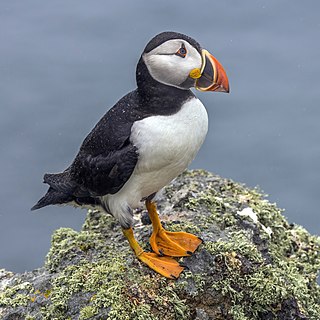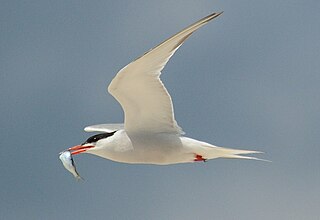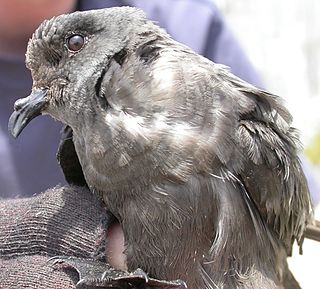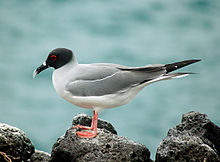
Seabirds are birds that are adapted to life within the marine environment. While seabirds vary greatly in lifestyle, behaviour and physiology, they often exhibit striking convergent evolution, as the same environmental problems and feeding niches have resulted in similar adaptations. The first seabirds evolved in the Cretaceous period, and modern seabird families emerged in the Paleogene.

The Atlantic puffin, also known as the common puffin, is a species of seabird in the auk family. It is the only puffin native to the Atlantic Ocean; two related species, the tufted puffin and the horned puffin are found in the northeastern Pacific. The Atlantic puffin breeds in Russia, Iceland, Ireland, Norway, Greenland, Newfoundland and Labrador, Nova Scotia, and the Faroe Islands, and as far south as Maine in the west and France in the east. It is most commonly found in the Westman Islands, Iceland. Although it has a large population and a wide range, the species has declined rapidly, at least in parts of its range, resulting in it being rated as vulnerable by the IUCN. On land, it has the typical upright stance of an auk. At sea, it swims on the surface and feeds on zooplankton, small fish, and crabs, which it catches by diving underwater, using its wings for propulsion.

Gulls, or colloquially seagulls, are seabirds of the family Laridae in the suborder Lari. They are most closely related to the terns and skimmers and only distantly related to auks, and even more distantly to waders. Until the 21st century, most gulls were placed in the genus Larus, but that arrangement is now considered polyphyletic, leading to the resurrection of several genera. An older name for gulls is mews, which is cognate with German Möwe, Danish måge, Swedish mås, Dutch meeuw, Norwegian måke/måse and French mouette, and can still be found in certain regional dialects.

The family Procellariidae is a group of seabirds that comprises the fulmarine petrels, the gadfly petrels, the diving petrels, the prions, and the shearwaters. This family is part of the bird order Procellariiformes, which also includes the albatrosses and the storm petrels.

The common tern is a seabird in the family Laridae. This bird has a circumpolar distribution, its four subspecies breeding in temperate and subarctic regions of Europe, Asia and North America. It is strongly migratory, wintering in coastal tropical and subtropical regions. Breeding adults have light grey upperparts, white to very light grey underparts, a black cap, orange-red legs, and a narrow pointed bill. Depending on the subspecies, the bill may be mostly red with a black tip or all black. There are several similar species, including the partly sympatric Arctic tern, which can be separated on plumage details, leg and bill colour, or vocalisations.

The pigeon guillemot is a species of bird in the auk family, Alcidae. One of three species in the genus Cepphus, it is most closely related to the spectacled guillemot. There are five subspecies of the pigeon guillemot; all subspecies, when in breeding plumage, are dark brown with a black iridescent sheen and a distinctive wing patch broken by a brown-black wedge. Its non-breeding plumage has mottled grey and black upperparts and white underparts. The long bill is black, as are the claws. The legs, feet, and inside of the mouth are red. It closely resembles the black guillemot, which is slightly smaller and lacks the dark wing wedge present in the pigeon guillemot.

The common murre also called the common guillemot or foolish guillemot,(Uria aalge) is a large auk. It has a circumpolar distribution, occurring in low-Arctic and boreal waters in the North Atlantic and North Pacific. It spends most of its time at sea, only coming to land to breed on rocky cliff shores or islands.

The ivory gull is a small gull, the only species in the genus Pagophila. It breeds in the high Arctic and has a circumpolar distribution through Greenland, northernmost North America, and Eurasia.

Forster's tern is a tern in the family Laridae. The genus name Sterna is derived from Old English "stearn", "tern", and forsteri commemorates the naturalist Johann Reinhold Forster.

The red-legged kittiwake is a seabird species in the gull family Laridae. It breeds in the Pribilof Islands, Bogoslof Island, and Buldir Island in the Bering Sea off the coast of Alaska, and the Commander Islands, Russia, and spends the winter at sea.

The black-legged kittiwake is a seabird species in the gull family Laridae.

The ashy storm petrel is a small, scarce seabird of the storm petrel family Hydrobatidae. It breeds colonially on islands off the coasts of California and Mexico, and is one of six species of storm petrel that live and feed in the rich California Current system.

The Galápagos hawk is a large hawk endemic to most of the Galápagos Islands.

The brown noddy or common noddy is a seabird in the family Laridae. The largest of the noddies, it can be told from the closely related black noddy by its larger size and plumage, which is dark brown rather than black. The brown noddy is a tropical seabird with a worldwide distribution, ranging from Hawaii to the Tuamotu Archipelago and Australia in the Pacific Ocean, from the Red Sea to the Seychelles and Australia in the Indian Ocean and in the Caribbean to Tristan da Cunha in the Atlantic Ocean. The brown noddy is colonial, usually nesting on elevated situations on cliffs or in short trees or shrubs. It only occasionally nests on the ground. A single egg is laid by the female of a pair each breeding season. In India, the brown noddy is protected in the PM Sayeed Marine Birds Conservation Reserve.

The black storm petrel is a small seabird of the storm petrel family Hydrobatidae. It is 23 cm in length, with a wingspan of 46–51 cm.

The fork-tailed storm petrel is a small seabird of the storm petrel family Hydrobatidae. It is the second-most abundant and widespread storm petrel and is the only bird in its family that is bluish-grey in colour.

Fowlsheugh is a coastal nature reserve in Kincardineshire, northeast Scotland, known for its 70-metre-high (230 ft) cliff formations and habitat supporting prolific seabird nesting colonies. Designated as a Site of Special Scientific Interest (SSSI) by Scottish Natural Heritage, the property is owned by the Royal Society for the Protection of Birds. Fowlsheugh can be accessed by a public clifftop trail, or by boats which usually emanate from the nearby harbour at the town of Stonehaven. Tens of thousands of pelagic birds return to the site every spring to breed, after wintering at sea or in more southern climates, principal species being puffins, razorbills, kittiwakes, fulmars and guillemots.

The Antarctic tern is a seabird in the family Laridae. It ranges throughout the southern oceans and is found on small islands around Antarctica as well as on the shores of the mainland. Its diet consists primarily of small fish and crustaceans. It is very similar in appearance to the closely related Arctic tern, but it is stockier, and it is in its breeding plumage in the southern summer, when the Arctic tern has shed old feathers to get its non-breeding plumage. The Antarctic tern does not migrate like the Arctic tern does, but it can still be found on a very large range. This tern species is actually more closely related to the South American tern.

Austral storm petrels, or southern storm petrels, are seabirds in the family Oceanitidae, part of the order Procellariiformes. These smallest of seabirds feed on planktonic crustaceans and small fish picked from the surface, typically while hovering. Their flight is fluttering and sometimes bat-like.

The term seabird is used for many families of birds in several orders that spend the majority of their lives at sea. Seabirds make up some, if not all, of the families in the following orders: Procellariiformes, Sphenisciformes, Pelecaniformes, and Charadriiformes. Many seabirds remain at sea for several consecutive years at a time, without ever seeing land. Breeding is the central purpose for seabirds to visit land. The breeding period is usually extremely protracted in many seabirds and may last over a year in some of the larger albatrosses; this is in stark contrast with passerine birds. Seabirds nest in single or mixed-species colonies of varying densities, mainly on offshore islands devoid of terrestrial predators. However, seabirds exhibit many unusual breeding behaviors during all stages of the reproductive cycle that are not extensively reported outside of the primary scientific literature.




























